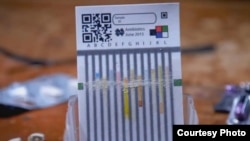Counterfeit and substandard medications are a serious problem in the developing world, potentially harming patients who desperately need medical treatment.
Some of these drugs — including the antibiotics ciprofloxacin and ceftriaxone — have been deemed essential by the World Health Organization for the treatment of infections. However, chemists in developing countries often do not have expensive instruments to determine whether a pill is genuine.
Now, a simple paper-based test may be the answer.
Instead of a $30,000 machine, a $1 paper card can test a drug in three minutes to determine whether the medication is inactive or of substandard quality. The tests come in 20-card packets.
Chemist Marya Lieberman of the University of Notre Dame in Indiana helped develop the inexpensive test.
"Really, this touches on issues of basic fairness and justice,” Lieberman said. “If people are paying for medicine, they deserve to get medicine.”
Lieberman said the card can be used to test a wide variety of medications.
"This card is designed to test antibiotics and tuberculosis medications, but it also works for some other drugs,” she said. “For example, for some diabetes medications and heart medications."
How it works
To see whether a drug is genuine, researchers crush a pill and rub the resulting powder across 12 lanes on the card. Each lane contains a test for a separate ingredient.
The card is then dipped in water. Chemicals on the card react to the powder and turn a certain color, which is compared to a color pattern from high quality pills from a drug manufacturer.
The process sorts out active from inactive ingredients, as well as harmful ingredients such as heavy metals.
Sometimes medications break down if they are stored improperly in hot temperatures. In one experiment, researchers subjected the antibiotic ceftriaxone to high temperatures and then used the card to color test the ingredients. When compared to the color chromatic pattern provided by the manufacturer, scientists saw the active ingredient in the antibiotic was different from the properly stored drug.
The researchers also tested antibiotics from western Kenya and Uganda, and found between 10 to 30 percent of the medications were of poor quality.
Range of benefits
Undergraduate student Sarah Bliese of Hamline University in St. Paul, Minnesota, helped develop the drug test card, which was unveiled at the annual meeting of the American Chemical Society.
It is important to flag fake drugs at every level of a health care system, Bliese says.
"It affects the patients that are supposed to be receiving these medications,” she said. “It affects the caregivers, such as the pharmacists and doctors, that are prescribing these medications because it starts to make them question their confidence in the medical system. And it affects the buyers that buy a drug from the manufacturers because they start to question the quality of this investment that they are making into this pharmaceutical.”
The test also may help authorities track down unscrupulous manufacturers of ineffective and unsafe drugs.
While the cards are used to test bogus and substandard drugs in the developing world, Lieberman says they eventually may be used to check the integrity of herbal medicines and nutritional supplements in the West, and even illegal street drugs.







